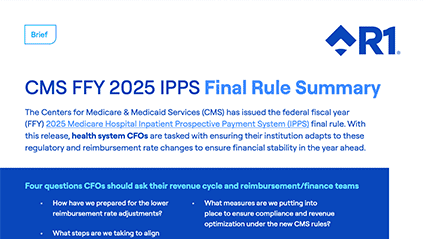The primary objective of healthcare providers in managed care contract talks with payers is to negotiate a profitable contract. But away from the bargaining table, providers should take note of important contract management and administration considerations that can help add leverage to the back end of the revenue cycle and, ultimately, to the bottom line.
When the goal is optimizing payer contracts for increased revenue, your adversary is ambiguity, and your ally is clarity. The more detailed and granular your contract language is, the more potential disputes and disagreements it will prevent and the more certainty you’ll have around future revenue.
Contract expert, Jon Kollerer, senior vice president of rules and contracts at R1, provides five managed care pointers that are critical for successful contract negotiation and administration:
1. Define clear payment hierarchies
When a medical service may qualify for multiple rates, the key to enforcing proper payment is hierarchy, specificity and clarity. Wherever possible, providers should add the payment hierarchy to the agreement rather than referencing provider manuals. In addition, providers need to ensure the hierarchy operates in descending order of provider value.
“Medical coding and billing are really complex and final payment depends on so many variables and qualifiers that attention to detail in defining payment hierarchies becomes essential for a provider’s financial health,” says Kollerer. “Vague contract language almost always benefits the party with the money, not the party trying to get paid.”
2. Specify rate interactions
It’s important to know when rates for services are mutually exclusive, that is, when a payment hierarchy applies, or paid in addition to, as with carveouts or fee schedules where multiple rates apply. In the payment scenario where multiple rates can stack, providers should be very specific about those rate interactions.
“The moral of this story again is clarity,” Kollerer says. “If you’re going to have rates that optionally stack, you need to be specific about when and in what scenarios, otherwise you’ll probably end up losing reimbursement.”
In situations where the discretion on rates is left to the payer, you should always assume that unclear rates will be enforced to the minimum extent of the language, which is why even seemingly simple rates should be defined to minimize ambiguity.
“That’s something that’s pretty common in our work, to incidentally find a higher value service that gets improperly reimbursed as if it were a lower value service because the hierarchy or rate interaction wasn’t explicit,” Kollerer warns. “When we find misalignment and dispute it, we then look for documentation that shows the meaning of the agreement is that the highest value service should drive payment.”
3. Eliminate assumptions with sample calculations
Managed care contract language typically specifies the way rate determinations are made. Those definitions can be complex and open to interpretation. Using sample calculations to augment and illustrate written rate definitions eliminates assumptions and ambiguity. While sample calculations for DRG are nearly universal, they can be spotty for other rates and neglecting them can be costly.
“This is a simple tactic that shouldn’t cost any additional negotiating capital – always put in a sample calculation,” Kollerer advises. “Showing the math can take out assumptions at the negotiating table and removes assumptions for those of us on the back end administering the rates.”
4. Require definition of regular updates
There are tens of thousands of medical codes documenting care, and those codes and code groups are designed to change. This year alone there are 249 new CPT codes and 159 new ICD-10 codes. That’s in addition to the annual Medicare reimbursement logic updates. How providers manage these regular changes can be critical to optimizing revenue. As a general rule of thumb, driving clarity on how new codes will be incorporated into agreements and payment structures is critical.
“Shifting codes and reimbursement logic naturally adds risk to agreements,” according to Kollerer. “Greater procedural specificity in handling for changes can mitigate the risk of these events.”
2022 CPT Code Changes
294
additions
63
deletions
93
revisions
5. Lead with care definitions
Negotiated rates should be paid for medical services delivered, but administration of those rates requires various qualifiers like DRGs, CPTs, and Revenue Codes to determine final payment amounts. However, when rates and rate definitions are reduced solely to qualifiers without regard to service level meaning, technicalities in coding, grouping, or charging can lead to diminished reimbursement.
“Especially for highest value services like trauma, burns, transplants, high-cost therapies or otherwise, providers can clearly define care scenarios to codify contract meaning,” says Kollerer. “By doing so they provide leverage to the back end of the revenue cycle when edge cases lead to administrative technicalities that prevent qualification based on a Revenue Code, DRG, or otherwise.”
The more consideration given to back-end administration on the front end of the contracting process, the better aligned agreement intent and actual administration will be. That, in turn, will help providers achieve their primary goal of negotiating profitable contracts while removing significant friction from the payment process – and from payer relationships.
The R1 Platform leverages the industry’s most intelligent technologies, proprietary RCM optimization engines and advanced analytics to transform the revenue cycle, including the rules engine that aligns contract terms and conditions with coding and billing processes to optimize and accelerate revenue.





